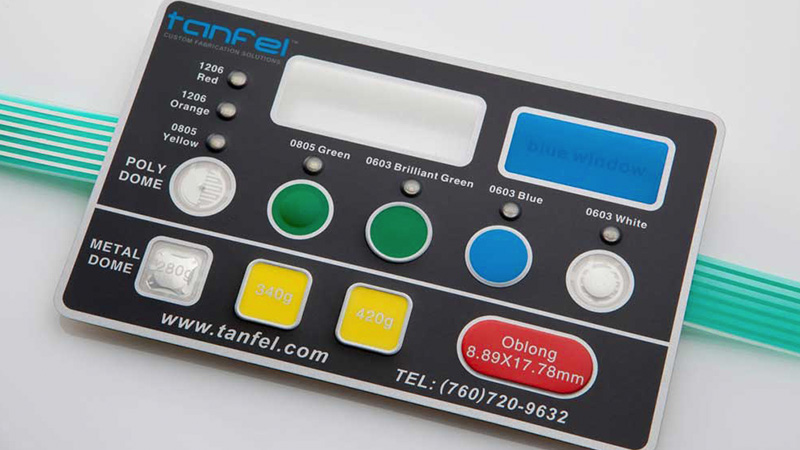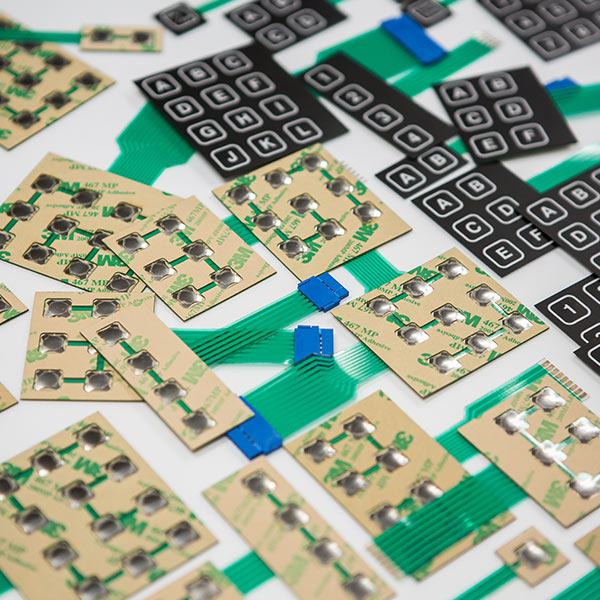Discover Exactly How Membrane Switches Assistance Touch-Sensitive Applications with Precision
Wiki Article
The Ultimate Resource on Membrane Layer Switches Over: Layout, Performance, and Applications
Membrane layer switches over function as a fascinating crossway of style and capability, playing a crucial function in modern-day individual interfaces throughout various fields. This source unloads the vital parts that add to their effectiveness, consisting of visuals overlays and circuit traces, while additionally clarifying the mechanisms behind their stress activation. As we discover the varied applications of membrane layer buttons, it comes to be evident that their adaptability and toughness are essential in atmospheres ranging from health care to consumer electronics. However, the nuances of their style and operational concepts might reveal also much deeper insights worth taking into consideration.
Recognizing Membrane Switches
Membrane switches are a kind of user interface modern technology commonly used in various digital devices, defined by their thin, adaptable style and functionality. These switches are composed of numerous layers that consist of visuals overlays, adhesive layers, and circuitry, enabling a effective and portable interface for users. They can be discovered in devices, medical tools, and commercial control board, offering a dependable technique for user interaction.Among the primary advantages of membrane layer switches is their ability to withstand impurities such as dust and dampness, making them suitable for atmospheres where longevity is necessary. Their inconspicuous style permits for smooth integration into different applications, while the adjustable visuals overlays improve customer experience by giving clear aesthetic feedback. Furthermore, membrane switches can fit a range of innovations, such as responsive comments and backlighting, further boosting their use.
The manufacturing procedure for membrane layer switches over normally includes display die-cutting, lamination, and printing methods, making sure precision and consistency in production. Overall, membrane layer changes represent a reliable and flexible service for modern electronic tools, integrating functionality with visual allure in customer interface style.
Key Elements and Layout Components
A range of key elements and style aspects come together to produce an effective membrane layer switch. At the core, the graphic overlay offers both practical and aesthetic objectives, providing an user-friendly user interface while securing interior parts from environmental variables. The option of products, normally polyester or polycarbonate, affects longevity and tactile responses.Beneath the overlay, the sticky layer makes sure the button adheres safely to the substratum, which can be plastic, steel, or glass. The spacer layer is important, as it keeps the required void between the circuit and the overlay layers, permitting efficient actuation. Membrane Switches. Circuit traces, generally made from conductive ink or adhesive, are published on an adaptable substrate, making it possible for electrical signals to be sent when pressure is applied
Layout considerations additionally consist of the arrangement of responsive domes or embossing that offer physical comments to the individual, improving the overall experience. Additionally, the design and spacing of the buttons need to be optimized for convenience of usage, guaranteeing that individuals can browse the user interface intuitively. Generally, these parts and design components function synergistically to create a trustworthy, useful membrane layer button customized to certain applications.
Capability and Operation System
At the heart of efficient performance for membrane Related Site switches over lies their functional mechanism, which assists in customer interaction through a simple yet efficient design. These switches run on the concept of pressure activation, where a user applies pressure to an assigned area of the switch (Membrane Switches). This activity presses the layers of the button, finishing an electric circuit that sends a signal to the connected gadgetThe building and construction typically consists of a leading visuals layer, a glue spacer layer, and a lower circuit layer, which collectively form a robust interface. When stress is used, the top layer collapses against the bottom circuit layer, allowing conductive traces to attach. This style not only allows clear responsive comments but likewise guarantees resilience and reliability, as the switches are often resistant to dirt and wetness.
Moreover, the convenience of membrane changes permits assimilation with different modern technologies, including LED indicators and microcontrollers, improving their performance. By offering a streamlined user interface that reduces mechanical wear, membrane layer switches over continue to be a favored selection in applications ranging from customer electronics to industrial devices, ensuring ideal performance and user contentment across varied environments.
Kinds Of Membrane Layer Buttons

An additional substantial classification is illuminated membrane buttons, which incorporate backlighting to improve visibility in low-light conditions. These buttons are often utilized in control panels and dashboards where clear presence is vital.
Moreover, there are custom-made membrane layer changes made to fulfill details dimensional, visual, and useful demands. These customizations can consist of one-of-a-kind forms, shades, and formats, allowing for seamless assimilation right into different tools.

Applications Throughout Different Industries
Just how do membrane layer switches improve performance throughout diverse sectors? In the clinical market, membrane buttons play an important duty in tools such as diagnostic tools and client surveillance systems, where dependability and convenience of cleaning are extremely important.In the automobile sector, membrane switches are generally used in control panels and control panels, offering user-friendly controls that enhance motorist safety and security and benefit. The customer electronics sector also takes advantage of their personalized and lightweight functions, making it possible for sleek styles for smartphones and home devices.
In addition, membrane buttons discover applications in commercial automation, where they add to efficient machinery operation and surveillance systems. Their resistance to dirt and moisture guarantees performance sought after problems (Membrane Switches). In addition, the food and drink industry employs membrane layer switches for devices control, where health and resilience are vital
Verdict
In verdict, membrane layer switches stand for an essential development in customer interface modern technology, defined by their special layout and performance. The flexibility of membrane switches facilitates their application across varied markets, from medical tools to consumer electronics.Membrane layer changes offer as an appealing crossway of style and functionality, playing a crucial function in modern-day customer interfaces across numerous markets.Membrane layer buttons are a type of user interface innovation widely utilized in various digital gadgets, characterized by their slim, adaptable style and functionality.At the heart of effective performance for membrane layer changes exists their operational mechanism, which helps with user communication via a straightforward yet effective style. These switches run on the concept of pressure activation, where a customer applies pressure to a designated area of the button.In verdict, membrane layer switches over represent a crucial advancement in her explanation customer interface technology, identified by their unique style and capability.
Report this wiki page